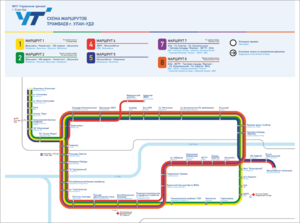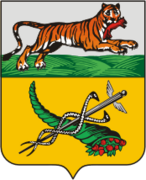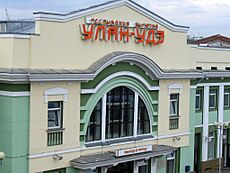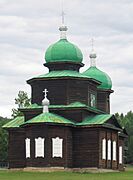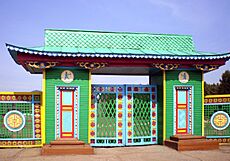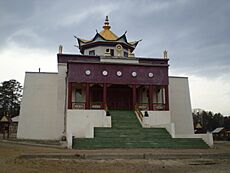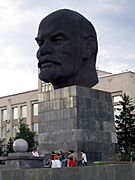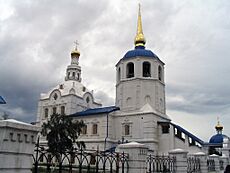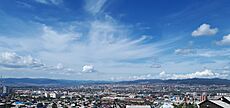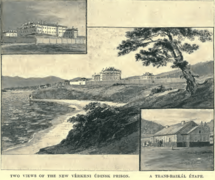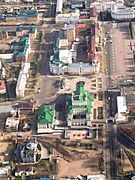Ulan-Ude facts for kids
Quick facts for kids Ulan-Ude (English)Улан-Удэ (Russian) Улаан-Үдэ (Buryat) |
|
|---|---|
| - City - | |
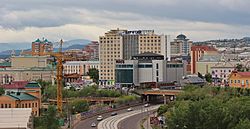 Ulan-Ude City Center |
|
|
|
|
| City Day | September's first Saturday |
| Administrative status | |
| Country | Russia |
| Federal subject | Republic of Buryatia |
| Administratively subordinated to | city of republic significance of Ulan-Ude |
| Capital of | Republic of Buryatia |
| Municipal status | |
| Urban okrug | Ulan-Ude Urban Okrug |
| Mayor | Igor Shutenkov |
| Representative body | City Council of Deputies |
| Statistics | |
| Area | 347.6 km2 (134.2 sq mi) |
| Population (2010 Census, preliminary) |
404,426 inhabitants |
| - Rank in 2010 | 45th |
| Density | 1,163/km2 (3,012/sq mi) |
| Founded | 1666 |
| City status since | 1775 |
| Postal code(s) | 6700xx |
| Dialing code(s) | +7 3012 |
| [ulan-ude-eg.ru Official website] | |
Ulan-Ude is the capital city of Buryatia, a republic in Russia. It is located about 100 kilometers (62 miles) southeast of Lake Baikal. The city sits on the Uda River, right where it meets the Selenga.
In 2021, about 437,565 people lived in Ulan-Ude. This makes it the third-largest city in the Russian Far East by population.
Contents
City Names Through History
Ulan-Ude has had a few different names over the years. When it was first built as a small fort in 1666, it was called Udinskoye. This name came from its location on the Uda River.
Around 1735, the settlement became known as Udinsk. It officially became a town with this name in 1775. In 1783, its name changed again to Verkhneudinsk. This new name meant "Upper Udinsk." It helped people tell it apart from another town called Nizhneudinsk ("Lower Udinsk"). That other town was on a different Uda River near Irkutsk.
The words "upper" and "lower" describe where the two cities are compared to each other. Verkhneudinsk is at the mouth of its river. Nizhneudinsk is further along its river. The city got its current name, Ulan-Ude, on July 27, 1934. In the Buryat language, "Ulan-Ude" means "red Uda." This name reflected the ideas of the Communist Party of the Soviet Union at the time.
Where is Ulan-Ude?
Ulan-Ude is about 5,640 kilometers (3,500 miles) east of Moscow. It is also about 100 kilometers (62 miles) southeast of Lake Baikal. The city is about 600 meters (1,969 feet) above sea level. It sits at the base of the Khamar-Daban and Ulan-Burgas mountain ranges. The Selenga River and its smaller river, the Uda, meet here. The Uda River actually divides the city into parts.
Rivers of Ulan-Ude
Two main rivers flow through Ulan-Ude: the Selenga and the Uda. The Selenga River is very important because it flows into Baikal Lake. It provides half of all the water that flows into the lake. The Selenga brings about 30 cubic kilometers (7.2 cubic miles) of water into Lake Baikal each year. This greatly affects how the lake's water is refreshed and how clean it stays. Many valuable fish live in the Selenga, like Omul, Siberian sturgeon, and taimen.
The Uda River is a branch that flows into the Selenga River. The Uda River is about 467 kilometers (290 miles) long.
Military Storage Area
Near Ulan-Ude, in a place called Vagzhanovo, there is a very large storage base for Russian military equipment. Before 2022, about 3,840 armored vehicles were stored there outdoors. Since the start of the war in Ukraine, more than 40% of these vehicles have been moved. There is also a Central Tank Reserve Base located within the Vagzhanovo area.
A Look Back at Ulan-Ude's History
The first people to live in the area of Ulan-Ude were the Evenks and later the Buryat Mongols. In 1666, Russian Cossacks founded Ulan-Ude as a fort called Udinskoye.
The city grew quickly because it was in a good location for trade. It became an important trading hub, connecting Russia with China and Mongolia. From 1690, it was the main administrative center for the Transbaikal region.
By 1775, it was known as Udinsk. In 1783, it officially became a city and was renamed Verkhneudinsk. A big fire in 1878 destroyed much of the city. After the fire, it was almost completely rebuilt.
When the Trans-Siberian Railway reached the city in 1900, Ulan-Ude grew even faster. Its population was only 3,500 in 1880, but it reached 126,000 by 1939.
From April to October 1920, Verkhneudinsk was the capital of the Far Eastern Republic. This was a state that existed in the eastern part of the Russian Far East from 1920 to 1922. On July 27, 1934, the city was officially renamed Ulan-Ude.
People of Ulan-Ude
| Historical population | ||
|---|---|---|
| Year | Pop. | ±% |
| 1897 | 8,086 | — |
| 1926 | 29,425 | +263.9% |
| 1939 | 125,690 | +327.2% |
| 1959 | 175,172 | +39.4% |
| 1970 | 253,569 | +44.8% |
| 1979 | 300,370 | +18.5% |
| 1989 | 352,530 | +17.4% |
| 2002 | 374,854 | +6.3% |
| 2010 | 404,426 | +7.9% |
| 2021 | 437,565 | +8.2% |
| Source: Census data | ||
In 2021, about 437,565 people lived in Ulan-Ude. This was an increase from 404,426 people in 2010. Ulan-Ude is the third-largest city in eastern Siberia by population. It ranks 45th among all cities in Russia. About 600,000 people live in the wider urban area around the city.
In 2021, the main ethnic groups in Ulan-Ude were:
- Russians: 61.4%
- Buryats: 35.1%
- Others: 3.5%
Ulan-Ude is an important center for Tibetan Buddhism in Russia. The important Ivolginsky datsan (a Buddhist monastery) is located about 23 kilometers (14 miles) from the city.
Getting Around Ulan-Ude
Ulan-Ude is a key stop on the Trans-Siberian Railway. This main railway line connects Irkutsk and Chita. It is also where the Trans-Mongolian line begins. This line goes south through Mongolia all the way to Beijing in China.
The city is also on the M55 section of the Baikal Highway. This is a major federal road that is part of the Trans-Siberian Highway leading to Vladivostok. For air travel, Ulan-Ude has the Ulan-Ude Airport (also called Baikal Airport). There is also a smaller airport, Ulan-Ude Vostochny Airport. Inside the city, people can travel by tram, bus, and marshrutka (shared taxis).
Culture and Sights
Until 1991, Ulan-Ude was a closed city, meaning foreigners were not allowed to visit. The historical center of Ulan-Ude has many old merchant houses. These houses are beautifully decorated with wood and stone carvings. They are great examples of Russian classic architecture.
The city has a large ethnographic museum. This museum tells the story of the people who have lived in the region. One of the most famous sights is a very large and unusual statue of the head of Vladimir Lenin in the central square. It is the largest Lenin head in the world. It was built in 1970 to celebrate 100 years since Lenin's birth. The statue weighs 42 tons and is 7.7 meters (25 feet) tall.
Places to See
- The Ethnographic Museum of the peoples of Transbaikal is one of Russia's largest outdoor museums. It has historical items from ancient times until the mid-20th century. This includes a special collection of wooden buildings from Siberia.
- Odigitrievsky Cathedral is an Eastern Orthodox Church. It was the first stone building in the city and is a beautiful example of Siberian baroque architecture. The cathedral is special because it was built in an area with a lot of earthquakes. It stands in the city center where the Uda River flows into the Selenga.
- The monument of Lenin's head is in the main town square, called the Square of the Soviets. This huge monument weighs 42 tons and is 7.7 meters (25 feet) tall. It was opened in 1971.
Climate
Ulan-Ude has a climate that is mostly a humid steppe climate. This means it's quite dry, like a grassland. It also has features of a humid continental climate and a subarctic climate. The winters are long, dry, and very cold. The summers are short but very warm. Not much rain or snow falls, and most of it happens in the warmer months.
The hottest temperature ever recorded was 40.6°C (105.1°F) on July 8, 2016. The coldest temperature ever recorded was -54.4°C (-65.9°F) on January 6, 1931. From December 31 to February 1, the temperature has never risen above freezing.
| Month | Jan | Feb | Mar | Apr | May | Jun | Jul | Aug | Sep | Oct | Nov | Dec | Year |
|---|---|---|---|---|---|---|---|---|---|---|---|---|---|
| Record high °C (°F) | −0.4 (31.3) |
7.9 (46.2) |
19.8 (67.6) |
28.7 (83.7) |
35.6 (96.1) |
40.0 (104.0) |
40.6 (105.1) |
39.7 (103.5) |
32.2 (90.0) |
24.7 (76.5) |
11.3 (52.3) |
5.2 (41.4) |
40.6 (105.1) |
| Mean daily maximum °C (°F) | −17.6 (0.3) |
−10.6 (12.9) |
0.4 (32.7) |
10.7 (51.3) |
18.6 (65.5) |
25.5 (77.9) |
27.5 (81.5) |
24.2 (75.6) |
16.8 (62.2) |
6.9 (44.4) |
−5.2 (22.6) |
−14.8 (5.4) |
6.9 (44.4) |
| Daily mean °C (°F) | −22.8 (−9.0) |
−17.5 (0.5) |
−6.7 (19.9) |
3.4 (38.1) |
10.9 (51.6) |
17.9 (64.2) |
20.6 (69.1) |
17.7 (63.9) |
10.0 (50.0) |
0.8 (33.4) |
−10.3 (13.5) |
−19.4 (−2.9) |
0.4 (32.7) |
| Mean daily minimum °C (°F) | −27.2 (−17.0) |
−23.5 (−10.3) |
−13.0 (8.6) |
−3.0 (26.6) |
3.8 (38.8) |
11.1 (52.0) |
14.6 (58.3) |
12.3 (54.1) |
4.6 (40.3) |
−4.0 (24.8) |
−14.4 (6.1) |
−23.2 (−9.8) |
−5.2 (22.6) |
| Record low °C (°F) | −54.4 (−65.9) |
−44.9 (−48.8) |
−40.4 (−40.7) |
−28.0 (−18.4) |
−15.1 (4.8) |
−3.9 (25.0) |
1.2 (34.2) |
−4.0 (24.8) |
−11.4 (11.5) |
−27.9 (−18.2) |
−38.0 (−36.4) |
−48.8 (−55.8) |
−54.4 (−65.9) |
| Average precipitation mm (inches) | 5 (0.2) |
3 (0.1) |
3 (0.1) |
6 (0.2) |
18 (0.7) |
34 (1.3) |
64 (2.5) |
63 (2.5) |
27 (1.1) |
7 (0.3) |
9 (0.4) |
11 (0.4) |
250 (9.8) |
| Average extreme snow depth cm (inches) | 12 (4.7) |
12 (4.7) |
4 (1.6) |
0 (0) |
0 (0) |
0 (0) |
0 (0) |
0 (0) |
0 (0) |
0 (0) |
3 (1.2) |
9 (3.5) |
12 (4.7) |
| Average rainy days | 0 | 0.04 | 1 | 6 | 10 | 14 | 16 | 15 | 13 | 7 | 1 | 0 | 83 |
| Average snowy days | 15 | 11 | 9 | 8 | 2 | 0.03 | 0 | 0 | 1 | 8 | 17 | 18 | 89 |
| Average relative humidity (%) | 77 | 75 | 66 | 53 | 49 | 57 | 64 | 69 | 68 | 68 | 76 | 78 | 67 |
| Mean monthly sunshine hours | 115 | 155 | 225 | 248 | 287 | 288 | 270 | 247 | 211 | 167 | 113 | 92 | 2,418 |
| Source 1: Погода и Климат | |||||||||||||
| Source 2: NOAA (sun, 1961-1990) | |||||||||||||
Economy
The Ulan-Ude Aviation Plant is a major factory located in Ulan-Ude. It builds aircraft.
Mongol Rally
Ulan-Ude is the final destination for the Mongol Rally. This is an adventure challenge where people drive across Europe and Asia to reach Ulan-Ude.
Famous People from Ulan-Ude
- Dmitry Masleev, a pianist
- Oksana Omelianchik, an artistic gymnast
- Irina Pantaeva, a model who appeared in Sports Illustrated
- Alexander Slastin, an actor
- Inna Stepanova, an Olympic archer
- Gunsyn Tsydenova, a politician
Gallery
-
Ulan-Ude railway station on the Trans-Siberian Railway
-
A Russian Old Believer church moved to the ethnographic museum in Ulan-Ude
-
The largest head of Soviet leader Vladimir Lenin ever built was in Ulan-Ude as of 2018
Panoramic view of Ulan-Ude
Sister Cities
Ulan-Ude is twinned with several cities around the world. This means they have special friendly relationships.
 Anyang, South Korea
Anyang, South Korea Berkeley, USA
Berkeley, USA Changchun, China
Changchun, China Chita, Russia
Chita, Russia Darkhan, Mongolia
Darkhan, Mongolia Donetsk, Ukraine
Donetsk, Ukraine Elista, Russia
Elista, Russia Erdenet, Mongolia
Erdenet, Mongolia Erenhot, China
Erenhot, China Grozny, Russia
Grozny, Russia Haeju, North Korea
Haeju, North Korea Hohhot, China
Hohhot, China Hulunbuir, China
Hulunbuir, China Lanzhou, China
Lanzhou, China Manzhouli, China
Manzhouli, China Rumoi, Japan
Rumoi, Japan Taipei, Taiwan
Taipei, Taiwan Ulaanbaatar, Mongolia
Ulaanbaatar, Mongolia Ulanqab, China
Ulanqab, China Yalta, Ukraine
Yalta, Ukraine Yamagata, Japan
Yamagata, Japan Yeongwol County, South Korea
Yeongwol County, South Korea
See also
 In Spanish: Ulán-Udé para niños
In Spanish: Ulán-Udé para niños



